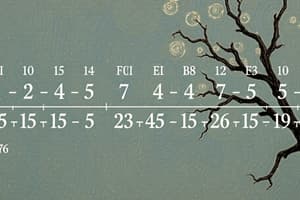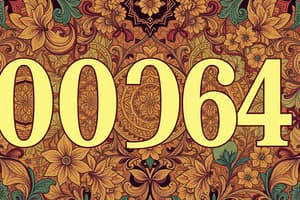Podcast
Questions and Answers
What are the symbols used in the hexadecimal number system?
What are the symbols used in the hexadecimal number system?
The symbols used in the hexadecimal number system are 0, 1, 2, 3, 4, 5, 6, 7, 8, 9, A, B, C, D, E, and F.
Which number systems are used by computers and which are used by humans?
Which number systems are used by computers and which are used by humans?
Binary and hexadecimal number systems are used by computers, while the decimal system is used by humans.
Convert the decimal number 10 to its binary equivalent.
Convert the decimal number 10 to its binary equivalent.
The binary equivalent of the decimal number 10 is 1010.
What is the base of the octal number system, and what symbols does it use?
What is the base of the octal number system, and what symbols does it use?
What is the result of converting the binary number 1111 to decimal?
What is the result of converting the binary number 1111 to decimal?
How would you express the decimal number 25 in hexadecimal?
How would you express the decimal number 25 in hexadecimal?
Describe the main difference between binary and decimal number systems.
Describe the main difference between binary and decimal number systems.
What is the binary representation of the decimal number 117?
What is the binary representation of the decimal number 117?
How is the value of 'k' defined in base 2 powers?
How is the value of 'k' defined in base 2 powers?
Illustrate the addition of binary numbers 10101 and 11001.
Illustrate the addition of binary numbers 10101 and 11001.
What is the hexadecimal value of the decimal number 451?
What is the hexadecimal value of the decimal number 451?
Using the rule for multiplying powers, what is the result of 2⁶ * 2¹⁰?
Using the rule for multiplying powers, what is the result of 2⁶ * 2¹⁰?
What is the octal equivalent of the binary number $1011010111_2$?
What is the octal equivalent of the binary number $1011010111_2$?
How do you convert the binary number $1010111011_2$ to hexadecimal?
How do you convert the binary number $1010111011_2$ to hexadecimal?
Explain the technique used to convert octal $1076_8$ to hexadecimal.
Explain the technique used to convert octal $1076_8$ to hexadecimal.
What is the binary representation of the octal number $703_8$?
What is the binary representation of the octal number $703_8$?
What binary number corresponds to the hexadecimal value $1AF$?
What binary number corresponds to the hexadecimal value $1AF$?
What is the correct binary conversion process for the octal digit 6?
What is the correct binary conversion process for the octal digit 6?
Convert the binary number $1110101_2$ to octal.
Convert the binary number $1110101_2$ to octal.
What is the octal equivalent of the hexadecimal number $1F0C_{16}$?
What is the octal equivalent of the hexadecimal number $1F0C_{16}$?
How do you convert the binary number $101010_2$ to octal?
How do you convert the binary number $101010_2$ to octal?
What is the hexadecimal equivalent of the binary number $11110000_2$?
What is the hexadecimal equivalent of the binary number $11110000_2$?
What method is used to convert a decimal number to binary?
What method is used to convert a decimal number to binary?
Convert the decimal number $125_{10}$ to binary.
Convert the decimal number $125_{10}$ to binary.
How do you convert the decimal fraction $0.6875_{10}$ to binary?
How do you convert the decimal fraction $0.6875_{10}$ to binary?
Explain the technique for converting binary to decimal.
Explain the technique for converting binary to decimal.
Convert the binary number $101011_2$ to decimal.
Convert the binary number $101011_2$ to decimal.
What is the conversion process from octal to decimal?
What is the conversion process from octal to decimal?
Convert the octal number $724_8$ to decimal.
Convert the octal number $724_8$ to decimal.
Describe how to convert hexadecimal numbers to decimal.
Describe how to convert hexadecimal numbers to decimal.
What is the decimal equivalent of a hexadecimal number such as $1A3_{16}$?
What is the decimal equivalent of a hexadecimal number such as $1A3_{16}$?
What is the decimal equivalent of the hexadecimal number $C3F_{16}$?
What is the decimal equivalent of the hexadecimal number $C3F_{16}$?
Convert the octal number $257_8$ to binary.
Convert the octal number $257_8$ to binary.
What is the binary equivalent of the hexadecimal number $3B7_{16}$?
What is the binary equivalent of the hexadecimal number $3B7_{16}$?
How would you express $97_{10}$ in octal?
How would you express $97_{10}$ in octal?
If the decimal number $0.625_{10}$ is converted to octal, what is the result?
If the decimal number $0.625_{10}$ is converted to octal, what is the result?
Find the octal equivalent of $456.75_{10}$.
Find the octal equivalent of $456.75_{10}$.
What is the hexadecimal representation of the decimal number $255_{10}$?
What is the hexadecimal representation of the decimal number $255_{10}$?
Convert the decimal number $(7.125)_{10}$ to octal.
Convert the decimal number $(7.125)_{10}$ to octal.
What is the decimal result of $B2D_{16}$?
What is the decimal result of $B2D_{16}$?
Flashcards
Decimal Number System
Decimal Number System
A number system with base 10, using digits 0-9.
Binary Number System
Binary Number System
A number system with base 2, using digits 0 and 1.
Octal Number System
Octal Number System
A number system with base 8, using digits 0-7.
Hexadecimal Number System
Hexadecimal Number System
Signup and view all the flashcards
Base of a Number System
Base of a Number System
Signup and view all the flashcards
Conversion between Number Systems
Conversion between Number Systems
Signup and view all the flashcards
Binary to Decimal Conversion
Binary to Decimal Conversion
Signup and view all the flashcards
Decimal to Binary Conversion
Decimal to Binary Conversion
Signup and view all the flashcards
Octal to Decimal Conversion
Octal to Decimal Conversion
Signup and view all the flashcards
Hexadecimal to Decimal Conversion
Hexadecimal to Decimal Conversion
Signup and view all the flashcards
Least Significant Bit (LSB)
Least Significant Bit (LSB)
Signup and view all the flashcards
Base Conversion
Base Conversion
Signup and view all the flashcards
Power of 2
Power of 2
Signup and view all the flashcards
Power of 8
Power of 8
Signup and view all the flashcards
Power of 16
Power of 16
Signup and view all the flashcards
Decimal to Octal Conversion
Decimal to Octal Conversion
Signup and view all the flashcards
Decimal to Hexadecimal Conversion
Decimal to Hexadecimal Conversion
Signup and view all the flashcards
Hexadecimal to Binary Conversion
Hexadecimal to Binary Conversion
Signup and view all the flashcards
Octal to Binary Conversion
Octal to Binary Conversion
Signup and view all the flashcards
Hexadecimal
Hexadecimal
Signup and view all the flashcards
Octal
Octal
Signup and view all the flashcards
Binary
Binary
Signup and view all the flashcards
kilo (k) in Computers
kilo (k) in Computers
Signup and view all the flashcards
Binary Addition (carry)
Binary Addition (carry)
Signup and view all the flashcards
Multiplying Powers
Multiplying Powers
Signup and view all the flashcards
Binary Addition: 11 + 11
Binary Addition: 11 + 11
Signup and view all the flashcards
Binary to Octal conversion
Binary to Octal conversion
Signup and view all the flashcards
Binary to Hexadecimal conversion
Binary to Hexadecimal conversion
Signup and view all the flashcards
Octal to Hexadecimal conversion
Octal to Hexadecimal conversion
Signup and view all the flashcards
Hexadecimal to Octal conversion
Hexadecimal to Octal conversion
Signup and view all the flashcards
Octal digit
Octal digit
Signup and view all the flashcards
Hexadecimal digit
Hexadecimal digit
Signup and view all the flashcards
Decimal
Decimal
Signup and view all the flashcards
Study Notes
Number Systems
- Decimal system uses base 10, with symbols 0-9. Used by humans.
- Binary system uses base 2, with symbols 0 and 1. Used by computers.
- Octal system uses base 8, with symbols 0-7.
- Hexadecimal system uses base 16, with symbols 0-9 and A-F. Used by computers.
Conversion Techniques
- Decimal to Binary: Divide the decimal number by 2 repeatedly, keeping track of the remainders. The remainders in reverse order form the binary equivalent.
- Decimal to Octal: Divide the decimal number by 8 repeatedly, keeping track of the remainders.
- Decimal to Hexadecimal: Divide the decimal number by 16 repeatedly, keeping track of the remainders. Convert remainders greater than 9 to their hexadecimal equivalent (A=10, B=11, C=12, D=13, E=14, F=15).
- Binary to Decimal: Multiply each bit by 2 raised to the power of its position (starting from 0 on the right). Sum the results.
- Octal to Decimal: Multiply each octal digit by 8 raised to the power of its position (starting from 0 on the right). Sum the results.
- Hexadecimal to Decimal: Multiply each hexadecimal digit by 16 raised to the power of its position (starting from 0 on the right). Sum the results.
- Octal to Binary: Convert each octal digit to its 3-bit binary equivalent.
- Hexadecimal to Binary: Convert each hexadecimal digit to its 4-bit binary equivalent.
- Binary to Octal: Group the bits in threes (starting from the right). Convert each group to its octal equivalent.
- Binary to Hexadecimal: Group the bits in fours (starting from the right). Convert each group to its hexadecimal equivalent.
- Octal to Hexadecimal: Convert the octal number to binary, then convert the binary number to hexadecimal.
Common Powers of 2
- 210 = 1024 (kilo)
- 220 = 1,048,576 (Mega)
- 230 = 1,073,741,824 (Giga)
Binary Arithmetic
- Binary addition and multiplication follow rules similar to decimal arithmetic.
Additional Notes
- Common number systems include decimal, binary, octal, and hexadecimal
- Understanding conversion between different number systems is critical for many computer science applications.
- Specific arithmetic rules apply for each number system.
Studying That Suits You
Use AI to generate personalized quizzes and flashcards to suit your learning preferences.




